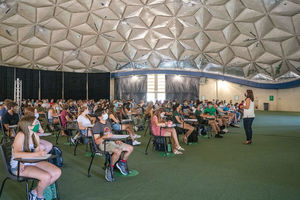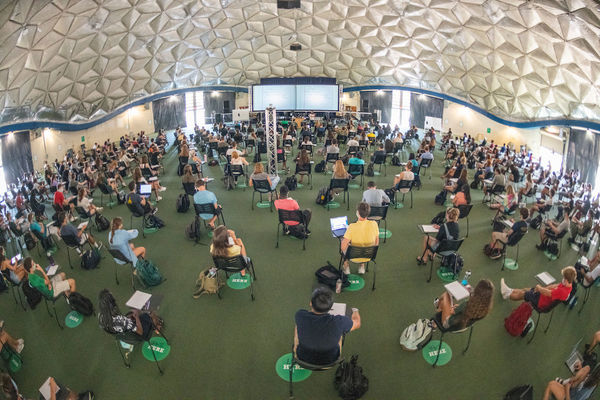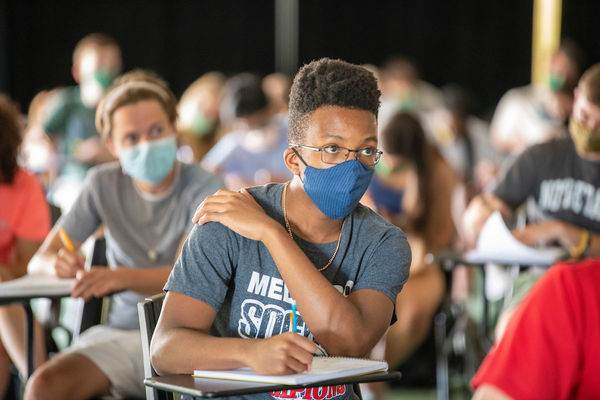
Editor’s note: As classes resume on campus during this unprecedented time, faculty and staff members are, as always, HERE for Notre Dame students. Whether work is done physically on campus or remotely, the collective purpose remains to offer an unsurpassed undergraduate education that nurtures the mind, body and spirit; and to advance human understanding through scholarship, research and post-baccalaureate programs that heal, unify and enlighten.

teaching the course titled “Chemical Principles”
in Stepan Center. (Photos by Barbara Johnston/
University of Notre Dame)
Three mornings a week, Assistant Teaching Professor Kelley M. H. Young teaches the course titled “Introduction to Chemical Principles” in Stepan. Not Stepan Chemistry Hall — a logical deduction — but Stepan Center, the geodesic dome on the north end of campus. The multipurpose facility, where concerts have been held and flu shots are administered, is currently a lecture hall.
This section of Chem 10171, which includes 250 undergraduate students, is normally held in Jordan Hall 101 or 105. But this year, with the University’s physical distancing guidelines, the side-by-side auditorium seating would not work. Stepan Center, on the other hand, offers ample space for physical distancing between students. This fall, classes are being held in many unconventional but roomy spaces across campus, including ballrooms.
“We’re taking extraordinary precautions to make it as safe as possible for the students to be back on campus because we care about them” Young said. “We care about their education. We’re trying to have them in the classroom where we believe optimal learning occurs and we can best facilitate how they learn.”
Up until two weeks ago, it had been about five months since Young had been on campus.
“I am very glad to be back. I really like what I do,” she said, while admitting, returning has been a little surreal. “This is the most people I’ve been around in months, so it feels brand new again. It’s somewhat scary, but also exciting to be back where we all like to be.”

would have normally met for class in a Jordan Hall auditorium, but the seating arrangement
would have had students side by side, not workable under the current circumstances.
As a professor who regularly teaches in front of hundreds of students and a mom of two young children, Young is very conscious of safety measures.
“When I’m in my office alone, like now,” she said during a Zoom interview, “my door is closed and my face mask is off. But when I leave my office, my face mask is on and it stays on when I am on campus. There’s also lots of hand-washing.”
Brian Baker, the Rev. John A. Zahm Professor of Structural Biology and chair of the Department of Chemistry and Biochemistry, is content to be on campus and in his office and lab, across Angela Boulevard, at the Harper Cancer Research Institute.
Baker recognizes that in-person instruction is preferable, especially at a place like Notre Dame where educating the mind and the heart occurs inside and outside the classroom. As an immunologist, he’s also acutely aware of the dangers associated with the pandemic.
“I think if we’re careful and attentive we can do this safely,” Baker said about the University’s decision to bring students to campus for the semester. “We’re doing what we think is best with the information and resources we have.”
While almost all of the department’s faculty members are back on campus, Baker is aware of “some healthy skepticism” among his colleagues.
“One particular faculty member said to me, ‘Look, I want to teach and teaching in person is best. I’m going to be there on day one, but I’m also going to see how it goes and adjust accordingly,” Baker recalled.
“I recognize and understand the apprehension— I gave my colleague kudos. As scientists, we’re used to considering scenarios with a critical eye. We look at and think about data, so we’ve been hungry for some of the details and have been thinking hard about them. We’ve had scientific questions about things like airflow and HVAC systems and room densities and aerosols,” he said.
Baker noted that to help address the concerns of his colleague and others, the University has been transparent with data and information for those interested in a deeper dive.

“I give a lot of credit to our senior leadership,” Baker said of University President Rev. John I. Jenkins, C.S.C., and others. “Father John and both (provost emeritus) Tom Burish as well as our new provost Marie Lynn Miranda have worked hard to create an environment that lets concerns, questions and thoughts be heard and responded to.”
Meanwhile, back in Stepan Center, Young lectured about the parts of an atom and introduced students to quantum mechanics. After class, she acknowledged it was strange to teach with a mask, knowing students could not see her facial expressions. It was equally challenging to not be able to see their expressions.
“I am trying to deal with not being able to see my students,” Young said, adding that she will adapt.
“I think this year will be remembered as a time of adaptability, grace and patience,” she said. “I'm hoping grace and patience will flow from us to the students and from the students back to the faculty because we will be learning right along with them how to adapt to the changes.”
Originally published by at ndworks.nd.edu on August 14, 2020.